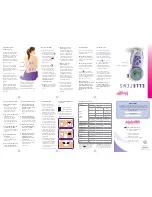
2 T-4000 Technical Bulletin
increase or up to decrease
the sensitivity.
5.
Check the output pressure.
If it is different from the value
found in step 3, turn the
sensitivity slider adjusting
screw until the output
pressure equals that value.
For low volume output
(plastic body) instruments,
use the output adjusting
screw to adjust the output
pressure.
6.
Check the sensitivity.
Change the control setting
on the dial by at least 5F
°
and note the new output
pressure. The change in
output pressure divided by
the change in dial setting is
the actual sensitivity.
7.
Repeat steps 4 through 6
until the desired sensitivity is
obtained.
T-4003 Range of Remote
Readjustment
The range of remote
readjustment is adjustable from
.15 to 2.5 F
°
/PSI (.012 to
.2C
°
/kPa) and is factory set at
0.5 F
°
/PSI (.04 C
°
/kPa). To
determine if the range of remote
readjustment needs to be
adjusted, proceed as follows:
1.
Insert the test gage into the
test port fitting and note the
output pressure.
2.
Set the master pressure to
4 psig (28 kPa).
3.
Turn the set point dial to 80F
and turn the calibration
screw to obtain a 3 psig
(21 kPa) output pressure.
4.
Set the master pressure to
14 psig (98 kPa).
5.
Turn the set point dial until
the output pressure returns
to 3 psig.
6.
The change in dial setting
divided by the 10 psig
(70 kPa) change in master
pressure (14 psig - 4 psig =
10 psig) is the actual range
of readjustment. If this is not
the desired range, move the
range of readjustment slider
(sensitivity slider in Fig. 1a)
toward the control port to
decrease or away from the
control port to increase the
range of readjustment.
Readjust the slider screw to
the pressure noted in step 1
above. Repeat steps 2
through 6 until the desired
range is obtained.
Set Point Adjustment
Before calibrating the instrument,
check to see if the output
pressure is already at an
appropriate value according to
the ambient temperature. For
example, if the actual room
temperature is below the set
point and the output signal is
calling for more heat, the
thermostat is doing its job and
does not require adjustment.
T-4002 and T-4100 (See Fig. 1)
1.
Insert the test gage.
2.
Furnish supply air to the
instrument (restricted supply
for T-4100).
3.
Note the ambient
temperature in the space.
4.
Turn the set point dial to that
temperature.
5.
Turn the calibration screw
until the output pressure is at
the mid spring range of the
controlled device.
6.
Turn the set point dial to the
desired set point.
T-4003 Set Point Adjustment
Insert the gage and set the
master pressure to one half of
the supply pressure. Follow
steps 3 through 6 under T-4002
Set Point Adjustment.
Archived Document


























